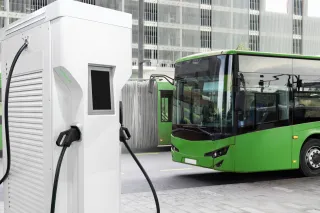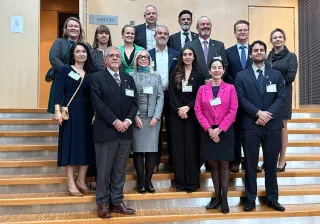A significant investment in the green transition for road transport and in the need to detach from fossil fuels is visible in the European debate and policy-making. The latest example of this is the Fit for 55 package, which is based on previous European legislative work, and the REPowerEU Plan, which reflects the current geopolitical reality and accelerates energy saving, clean energy and energy independence at the EU level. However, mobile work machines have practically no legislative framework that pushes them towards a green transition.
The impact of acts, taxation, policy instruments and legislation is crucial for the energy source transition in road transport. Emission ceilings are strongly guiding vehicle manufacturers towards electrification. The change in supply and value chains is tremendous, and it is reflected in the industrial context with Europe’s emerging industrial sector covering an entire value chain: the battery industry.
In the transition to alternative energy sources, a supporting infrastructure is a central part of the solution. The raw material resource base for sustainable bio-based fuels is limited and, at the same time, the demand for them is expected to expand rapidly from road transport to maritime and air transport and possibly to work machines. Biogas should be utilised in its entirety, but its refining to biomethane and its small-scale production may cause challenges in managing scaling and cost. Road transport is on a clear path towards electrification, and appropriate private and public charging infrastructure at home, at service locations, in urban environments, in industrial environments and along routes is going to be central for the users.
What kind of measures the green transition of transport and work machines require?
There are many key factors that a market change and the commissioning of new products require: a sufficient product and model range, the existence of supporting energy source infrastructure, real-life experiences and trust in the functionality of a solution, word-of-mouth and other practical knowledge base on the subject, the feasibility of procurements and systems and the availability of funding, the suitability of new energy sources for their intended use and for the process in professional settings, the total costs for the owner and competitiveness. All of these factors can be influenced, and they are formed through both public policy instruments and market-based supply and demand dynamics.
New alternative energy sources are also associated with uncertainties regarding their costs and the availability of products. Good examples of these uncertainties are the current difficulties in managing the supply chain of electric cars and green hydrogen, which acts as a chemical energy storage and whose increasing demand is easily anticipated regarding industry. Hydrogen or electrofuels synthesised from it are subject to high expectations in the transport sector despite the fact that this precious chemical will not have a real market to speak of for the next few years. There are also clear uncertainties regarding the formation of the prices.
Change towards a more environmentally friendly transport takes time
For light and heavy road transport, it is clear that the change in the market and the emergence of new energy sources will take a lot of time even in favourable conditions and with legislative support. The market and consumers are conservative. Product development, increased production and supply chains, the verification of new solutions and infrastructure solutions require time. An example for the opening of a new market can be found in electric cars. If the entry of the first commercial electric vehicles to the market at the beginning of 2010s is seen as the starting point, a mass market may be statistically achievable in approximately ten years – this can be seen in the development cycle of both electric passenger cars and electric buses.
Electric trucks are at the start of their development cycle right now. The energy source supplementing electricity, hydrogen, has been striving for the starting point for a while. In the green transition for road transport, maritime transport, air transport and railway transport, the research, development and innovation activities play a major role in supporting and accelerating the change. For the four mentioned modes of transport (road, railway, water, air), the ongoing ninth EU Framework Programme for Research and Innovation has established their own public and private sector co-development partnerships that promote the agenda on a European level.
Where do work machines stand in the wider energy source transition of the transport sector?
The mobile work machine sector is significant regarding its energy consumption and emissions. While Finland’s road transport CO2 emissions totalled approximately 11 million tonnes in 2020, the same figure for mobile work machines was approximately 1.8 million tonnes of CO2 – this is more than the total emissions of both vans and buses. Despite that, only modest actions have been taken towards mitigating the CO2 emissions of the work machine sector.
The mobile work machine sector is much more fragmented and versatile compared to road transport. A new energy source solution suitable for all work machines is nowhere near in sight. Industrial environments, cities and built environment, agriculture and forestry, mines, ports and storage facilities all have their own preconditions and demands for machines. Improved data collection concerning the work machine stock and its use would help us to understand and concretise future development and its measures.
How well the infrastructure of alternative energy sources can be implemented depends greatly on the environment of the work machine’s end user. This means that all across-the-board solutions should be implemented preferably in a technologically neutral manner and let the market – not the policy-making – ultimately select the most suitable combination of technologies and the solution. Sustainable and advanced biofuels (biofuel oil, biogas) and the obligations concerning their usage are going to be an important solution in the coming years, but there are indications that the wider green transition of transport and work machines will not be solved solely through a distribution obligation. The price increase of both fossil fuel components and sustainable biofuel components and the growing global demand for biofuels may increasingly benefit electricity as energy source from the point of view of the market.
Commissioning of greener work machines requires new legislation
The regulative and legislative framework guiding the green transition for the work machine sector is currently either underdeveloped or non-existent – this is true both globally and at the European level. For example, the substantial driving force in the road transport sector’s change, CO2 regulation, is missing altogether at the moment. The CO2 progression of the sector’s overall taxation (including car tax, vehicle tax, excise duties), which is usually used in the taxation of transport, is missing or much less steep. Research, development and innovation partnerships promoting the development and trials of new technologies and energy sources are more meagre in the work machine sector than in the transport sector.
The Six work machine cluster that is recognised and defined as part of Finland’s battery strategy and the industrial and jointly-funded development projects connected to it, which include electrification and hybridising as part of their strategic road maps, are currently showing promise. In the current European innovation landscape, the topic of work machines’ energy sources is unfortunately marginalised amid the web of framework programmes and partnerships. There is no extensive European cooperation platform and innovation funding package, such as the transport partnerships have, for the promotion of work machines’ energy source transition. Regarding this, the current situation is the same as in the CO2 regulation.
The green transition for the work machine sector, the utilisation of new technologies and energy sources and, through that, the improvement of energy efficiency and productivity and the cutting of emissions are possible, but it requires horizontal action in all relevant areas. A reform will require long-term investments in the product development of machines and infrastructure solutions and from the end users and the operation environment. Considering the Finnish work machine sector’s exporting industry, the threat posed by the transition waiting to emerge must be turned determinedly into an opportunity.
The VN TEAS research project, which is funded by the Prime Minister’s Office, will publish a report, Cost-effective Measures to Reduce Work Machine Emissions (TYKO2), addressing this subject on 19 October 2022.






